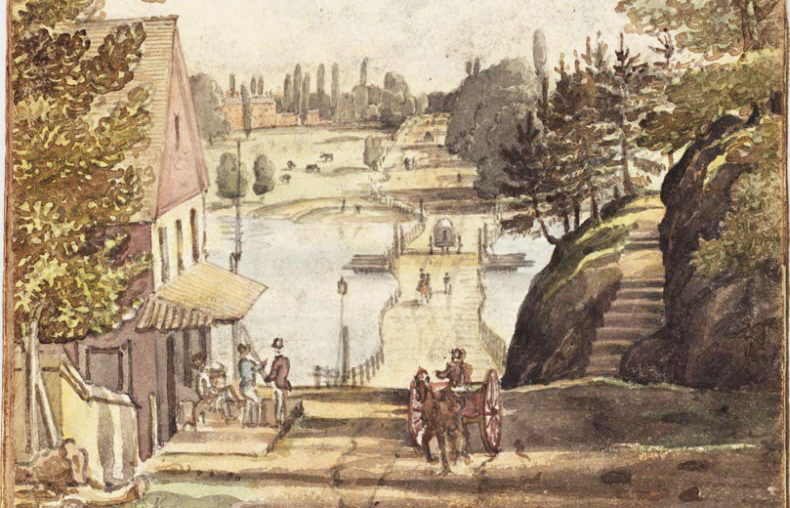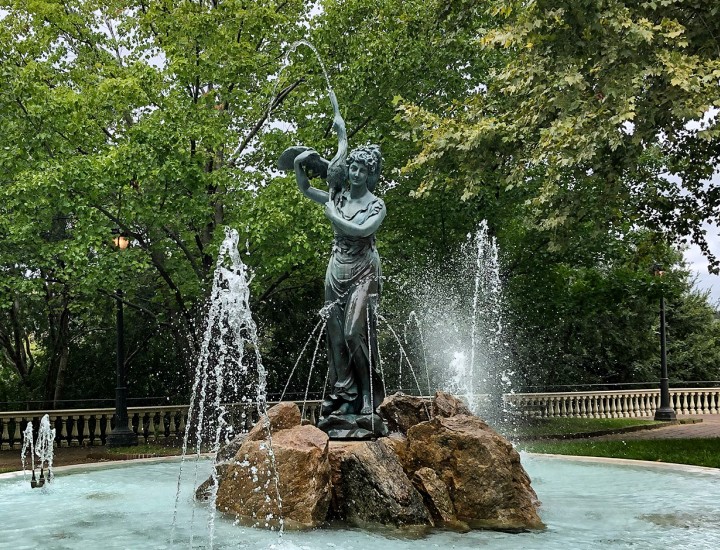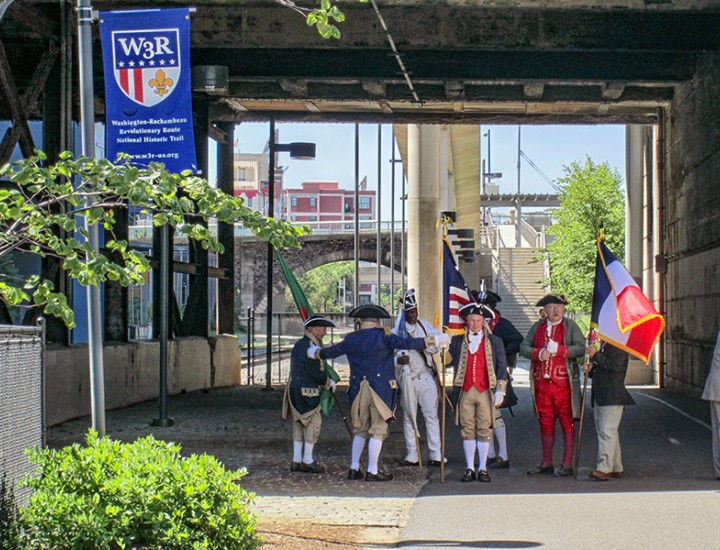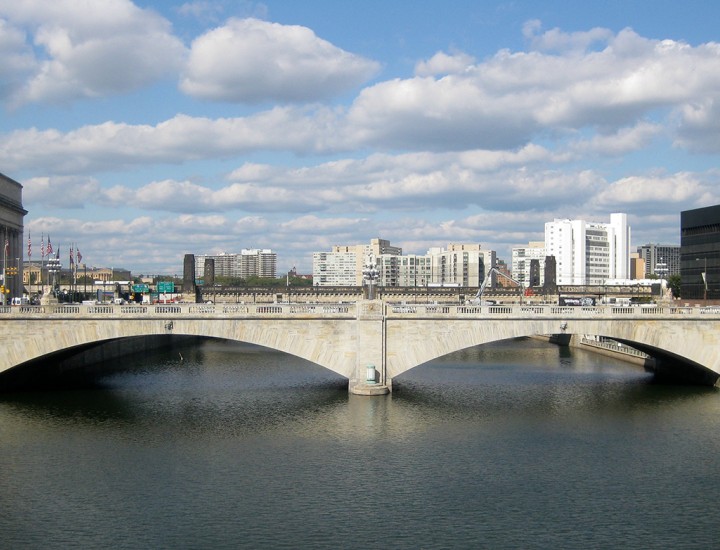Gray's Ferry Tavern and Gardens
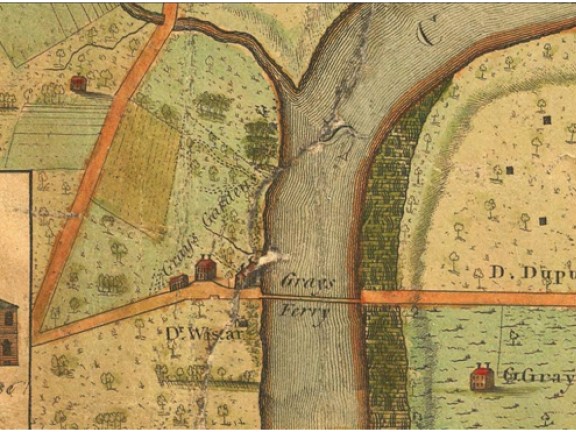
For more than a century, the Lower Ferry, or Gray's Ferry was the easiest way to access Philadelphia if you were traveling by land from the South. While there had been a ferry across the Schuylkill River at this location since the late 1600s, brothers George and Robert Gray dramatically improved the crossing when they inherited the land on either side of the Schuylkill in the 1740s. The brothers widened the road and built an inn and tavern on the west bank of the river, transforming the ferry from a waystation into a destination. Several of our founding fathers hosted a dinner for George Washington at the tavern in 1775, shortly after he was named Commander-in-Chief of the Patriot forces.
The property was overrun by the British during the Revolutionary War; the buildings were destroyed, and troops installed a floating bridge at the site of the ferry. After the end of the war, the brothers quickly rebuilt and installed their own floating bridge in place of the ferry. In the 1780s, the brothers worked with Samuel Vaughan to design and install beautiful pleasure gardens on the property. Gray's Tavern and Gray's Gardens became a popular resort destination, one of the first of its kind in America. Delegates of the Constitutional Convention were known to breakfast at the Tavern before a long day of deliberations, and Dolley Todd (the future Dolley Madison) stayed at the Inn with her children to avoid an outbreak of Yellow Fever.
1816 painting from The Sketchbook of Captain Joshua Rowley Watson showing the Gray's Ferry floating bridge, Gray's Ferry Tavern, and stairs to a portion of Gray's Gardens, www.philamuseum.org
The Gray's Ferry Tavern was built into the side of the hill near the riverbank, with two stories in the front and three in the back; large outdoor porches on the back of the house offered views of the river. The gardens were a fantasy, especially when compared to the bustling city that was a short ride away. A soldier visiting the gardens described "a veritable fairy scene with bower, grottoes, waterfalls, bridges, islands, and a most attractive Inn."
Reverend Manasseh Cutler, who visited Philadelphia in 1787, described a day trip to Bartram's Garden, Gray's Tavern and Gray's Gardens in great detail. (The journal is linked below - the description of the day trip begins on page 272, if you would like to read more about Bartram's Garden as well as Gray's Tavern and Gardens.) "A flight of steps, cut out of solid rock at the east end of the house" led to a large grass lawn, shaded with large trees behind the house. Beyond the lawn was a piazza overlooking the river, where meals were served. The lawn also connected to a serpentine gravel walk, which led to a large greenhouse full of exotic plants and fruit trees (citrus and pineapples). The large gardens, "all different in size and form" were connected by paths "none of them straight and no two alike." Summer houses, vine and flower covered arbors, and shady bowers were scattered throughout the gardens, and the borders contained "every kind of flower, one would think, that nature had ever produced, and with the utmost display of fancy as well as variety." The gardens also included wooded areas, a steep hill overlooking a "deep shady valley, in the midst of which was a purling stream of water, meandering among the rocks in its way down to the river." Beyond this valley was a garden with streams and arches built "in the Chinese style; the rails on the sides open work of various figures and beautifully painted." The paths were "a most happy imitation of nature" and contributed to the romantic effect of the garden, alternately hiding and displaying views of other areas of the garden. The gardens were so large and labyrinthine, that the members of Reverend Cutler's party quickly decided it was best not to wander off, in case they weren't able to find each other again. Along one of these paths, the group was "delightfully astonished with the view of one of the finest cascades in America (...) a broad sheet of water comes over a large horizontal rock and falls about seventy feet (...) in a large river, which empties into the Schuylkill just above us. Towards the river, small side paths led to outlooks over the river, grottos built into ledges of rocks, and more labyrinthine paths. The garden wound its way over hills and along cliffs, through valleys and vales, among large boulders and rocks, up and down winding staircases and meandering side paths, and included a wide variety of themed hideaways for visitors to discover, including a variety of hermitages and summer-house with a roof "in the Chinese form." The Reverend described feeling like he was "on enchanted ground, and could hardly help looking out for flying dragons, magic castles, little Fairies, Knight-errants, distressed Ladies, and all apparatus of eastern fable." He details encountering "art so blended with nature as hardly to be distinguished, and seems to be only an handmaid to her operations." Across the road from the house was a high hill, which ended abruptly by the river in a cliff 20 feet high. A set of stairs ascended the hill, leading to a grove of "walnuts, oaks, and pines, under which are arranged benches for one hundred people to sit, several long tables, etc." A variety of fruit trees and brambles surrounded the outdoor dining area, which offered beautiful views of the Schuylkill.
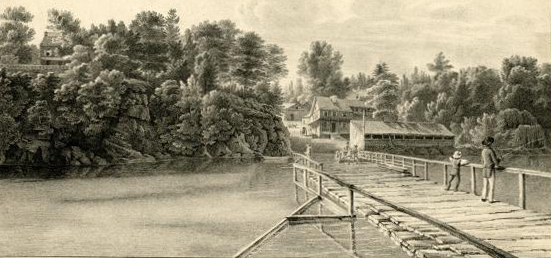 An 1830 view of the Gray's Ferry Floating Bridge, with Gray's Tavern and Gardens in the background by George Lehman, digitallibrary.hsp.org.
An 1830 view of the Gray's Ferry Floating Bridge, with Gray's Tavern and Gardens in the background by George Lehman, digitallibrary.hsp.org.
While portions of neighboring horticultural wonders Bartram's Garden and The Woodlands are still around today, Gray's Gardens were just a memory by the 1850s. The tavern started to lose popularity with the opening of the first permanent bridge across the Schuylkill at High Street (now Market Street) in 1803; changing ownership several times over the subsequent decades. The topography of the site changed dramatically with the construction of the Newkirk Viaduct in 1838 and with the addition of new rail lines and yards throughout the rest of the 1800s. What was once one of the most beautiful sights in the region transformed into a heavy industrial area for more than a century. Today, Bartram's Mile North has taken over the mantle of Gray's Gardens. Situated on the site of the former grove of trees and brambles overlooking the river, and continuing south beyond the historic Gray's Gardens, the trail and greenway serves as a respite for neighbors looking to experience a bit of greenery and beautiful views of the river in their back yards.
Resources:
https://heald.nga.gov/mediawiki/index.php/Gray%E2%80%99s_Garden
https://en.wikipedia.org/wiki/Gray%27s_Ferry_Tavern
https://hiddencityphila.org/2017/03/tracking-the-evolution-of-industry-at-34th-and-grays-ferry/
https://hiddencityphila.org/2014/03/pleasure-gardens-without-worry-in-the-city/
Manasseh Cutler Journal: http://www.archive.org/stream/lifejournalscorr01cutl#page/274/mode/2up
https://tclf.org/pioneer/samuel-vaughan/biography-samuel-vaughan
http://maps.archives.upenn.edu/WestPhila1777/map.php
Images:
https://philadelphiaencyclopedia.org/archive/gardens-public/
https://www.philamuseum.org/collections/permanent/299624.html?mulR=284164091|1#
http://librarycompany.org/mirrorofacity/section2.htm
https://digital.librarycompany.org/islandora/object/digitool%3A64152
https://digitallibrary.hsp.org/index.php/Detail/objects/249
